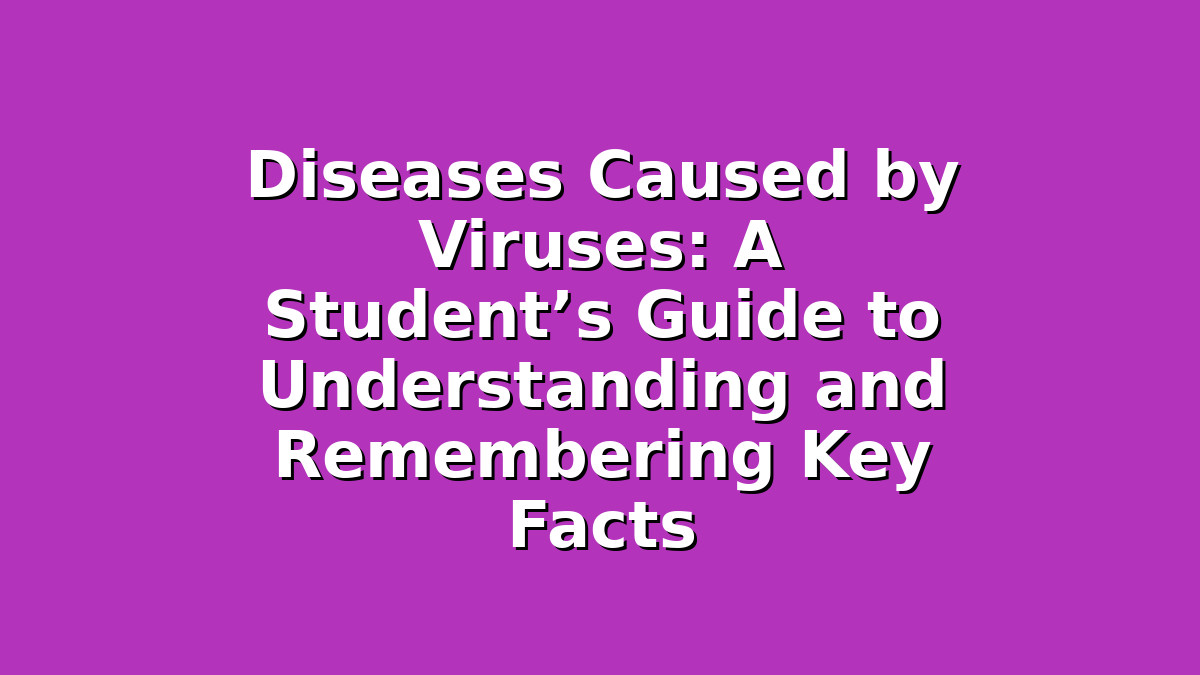When preparing for exams, especially in biology or health science, understanding diseases caused by viruses is crucial. Viruses are tiny infectious agents that can cause a wide range of illnesses, from the common cold to more serious diseases like influenza, HIV/AIDS, and COVID-19. Knowing how viruses affect the body, their transmission, and prevention methods not only helps you ace your exams but also keeps you informed about your health.
In this article, we will explore three important viral diseases: Influenza, Human Immunodeficiency Virus (HIV), and COVID-19. Alongside the detailed explanations, you’ll receive study tips tailored to help you grasp and retain this information efficiently.
—
1. Influenza: The Seasonal Viral Infection
What is Influenza?
Influenza, commonly known as the flu, is caused by influenza viruses. These viruses infect the respiratory system and are highly contagious. Flu seasons typically occur during the colder months, spreading rapidly through coughs, sneezes, and close contact.
Symptoms and Effects:
Symptoms include fever, chills, cough, sore throat, muscle aches, and fatigue. While many people recover within a week or two, influenza can be serious for young children, elderly individuals, and those with weakened immune systems.
Why It Matters for Students:
The flu can disrupt your study schedule due to fatigue and illness. Understanding flu prevention can help you avoid being sidelined during exam preparation.
Study Tip: Use Flashcards for Symptoms and Prevention
Create flashcards with common flu symptoms on one side and prevention methods on the other. For example, one card might say “Fever, cough, muscle aches” on one side and “Vaccination, hand washing, avoiding close contact” on the other. Reviewing these cards regularly can help reinforce your memory and make quick recall easier during exams.
—
2. Human Immunodeficiency Virus (HIV): A Chronic Viral Infection
What is HIV?
HIV attacks the immune system, specifically the CD4 cells (T cells) that help fight infections. If untreated, it can lead to Acquired Immunodeficiency Syndrome (AIDS), where the immune system becomes severely weakened.
Transmission:
HIV is transmitted through contact with infected bodily fluids such as blood, semen, vaginal fluids, and breast milk. Common routes include unprotected sexual contact, sharing needles, and from mother to child during birth or breastfeeding.
Symptoms and Treatment:
Early HIV infection may cause flu-like symptoms, but many people remain asymptomatic for years. Antiretroviral therapy (ART) is used to manage the virus, enabling people to live longer, healthier lives.
Study Tip: Use Mnemonics to Remember Transmission Modes
To memorize HIV transmission routes, try a simple mnemonic like “BSS” – Blood, Sexual contact, Sharing needles. Associating key points with easy-to-remember acronyms can significantly improve retention and make exam revision less stressful.
—
3. COVID-19: The Global Pandemic Virus
What is COVID-19?
Caused by the novel coronavirus SARS-CoV-2, COVID-19 emerged in late 2019 and rapidly became a global pandemic. It primarily affects the respiratory system but can impact multiple organs.
Symptoms and Impact:
Symptoms range from mild (fever, cough, loss of taste or smell) to severe (difficulty breathing, chest pain). COVID-19 has had a profound impact on education, forcing many students worldwide to adapt to remote learning and altered exam formats.
Prevention and Vaccination:
Wearing masks, social distancing, hand hygiene, and vaccination are key strategies to reduce transmission and protect communities.
Study Tip: Incorporate Current Events into Your Study
Use recent news articles and verified sources to stay updated on COVID-19 developments. Relating scientific facts to real-world events can deepen your understanding and make your study sessions more engaging. For example, when studying vaccines, look at how mRNA vaccines were developed and administered globally.
—
Conclusion: Mastering Viral Diseases with Smart Study Strategies
Understanding diseases caused by viruses is essential for your exams and personal health awareness. Influenza, HIV, and COVID-19 each present unique challenges and learning opportunities. By using study tools like flashcards, mnemonics, and connecting lessons to real-life events, you can improve your retention and confidence.
Remember, consistent revision and active engagement with the material are the keys to success. Don’t hesitate to form study groups, ask questions, and use a variety of resources. You’ve got this!
Good luck with your studies and stay healthy!
—

Responses